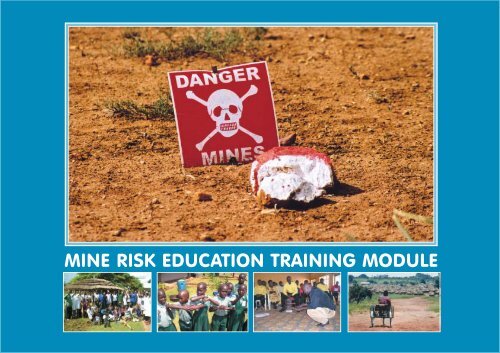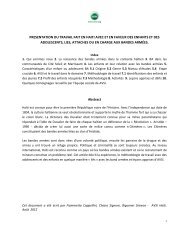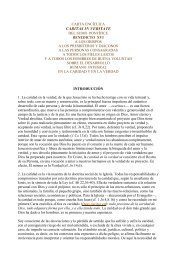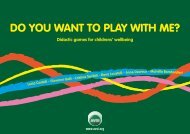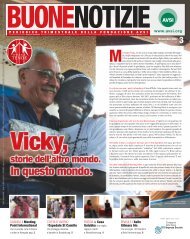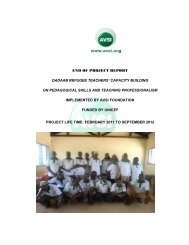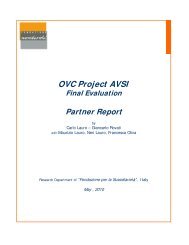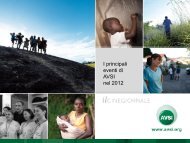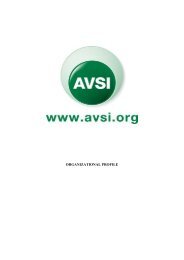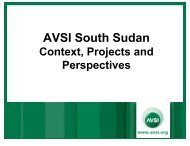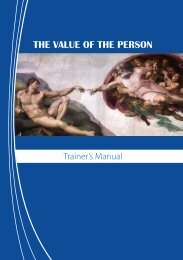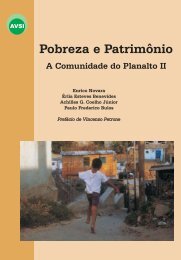Mine risk education training module - Avsi
Mine risk education training module - Avsi
Mine risk education training module - Avsi
Create successful ePaper yourself
Turn your PDF publications into a flip-book with our unique Google optimized e-Paper software.
MINE RISK EDUCATION TRAINING MODULE
PREFACE<br />
This is one in a series of <strong>training</strong> <strong>module</strong>s developed by AVSI to support the work of people dealing with children and communities in war situations.<br />
Previous publications were a <strong>training</strong> manual and handbook for community volunteer counselors (November, 2000) and a <strong>training</strong> manual and handbook<br />
for teachers on psychosocial issues (February, 2003).<br />
Each <strong>module</strong> in the series is designed to address specific topics in depth, based upon the approach, principles and practices presented in the first two<br />
publications.<br />
This <strong>training</strong> <strong>module</strong> is addressed to community resource persons to assist them in organising and presenting a <strong>training</strong> on <strong>Mine</strong> Risk Education (MRE).<br />
<strong>Mine</strong>s and unexploded ordnance (UXO) are seriously affecting our community physically, psychologically and economically. People need to know how to<br />
avoid unnecessary maiming and death due to mines and UXO, and AVSI believes that sensitization and awareness <strong>training</strong> can contribute in reducing the<br />
number of mine accidents, thus saving lives.<br />
This <strong>module</strong> is designed to share with you the experience AVSI has gained over the past years of conducting MRE <strong>training</strong> in Uganda. Since 2001, the<br />
Ministry of Health, the Uganda People’s Defence Forces (UPDF), district authorities and AVSI have collaborated to implement a community-based<br />
project focused on MRE at the grass-roots level. After many years of practice and implementation, what is presented in this <strong>module</strong> is the approach that<br />
we found to be most effective. We consider this a starting point on which you can build and give us feedback to improve continuously this important<br />
activity.<br />
ACKNOWLEDGEMENTS<br />
Special thanks to Captain Eng. Wilson Kabeera (UPDF), Bernard Ocen (Gulu District Rehabilitation Officer), Dr. Alice Nganwa (Senior Medical Officer,<br />
Ministry of Health) and Dr. Lucia Castelli (AVSI) for their invaluable leadership in developing the <strong>training</strong>s and producing this <strong>module</strong>.<br />
Many thanks also to all facilitators and participants who have contributed to the content of this <strong>module</strong> through their experience and feedback.<br />
This document has been produced with the financial assistance of the European Community (ECHO grant agreement number: ECHO/UGA/BUD/2004/<br />
01004). The views expressed herein should not be taken, in any way, to reflect the official opinion of the European Community.
MINE RISK EDUCATION<br />
TRAINING MODULE<br />
By<br />
Davide Naggi, Rachel Lambert, Mary Ann Kerins and Jeff Dixson<br />
Copyright: AVSI Published by:<br />
Funded by: European Commission Humanitarian Aid Office AVSI<br />
Design and production by: Acha Graphics East African Regional Office<br />
Photographs by: AVSI AVSI Plot No. 1119<br />
Ggaba Road<br />
Kampala, Uganda<br />
Humanitarian Aid<br />
EUROPEAN COMMISSION<br />
Ministry of Health<br />
Training Module 1, First Edition, July 2004<br />
c Copyright AVSI ISBN 9970 - 890 - 04 - 2<br />
Any part of this Training Module may be freely reproduced with the appropriate acknowledgement.
I<br />
N<br />
T<br />
R<br />
O<br />
D<br />
U<br />
C<br />
T<br />
I<br />
O<br />
N<br />
HOW TO USE THIS MODULE<br />
This <strong>module</strong> is designed to be used for <strong>training</strong> of trainers (TOT) to assist participants in organizing and presenting MRE <strong>training</strong>s.<br />
This <strong>module</strong> is divided into three sections:<br />
A INTRODUCTION Global background 3<br />
Approach to <strong>training</strong> 4<br />
Trainers 5<br />
Methods used in <strong>training</strong> 6<br />
How to organise a <strong>training</strong> 8<br />
Includes an overview of background information<br />
for trainers. In this section practical aspects are<br />
covered such as choosing target groups in the<br />
community, the approach used in the <strong>training</strong>, the<br />
basics of facilitation, suggested methods,<br />
suggestions for how to organize the <strong>training</strong> and<br />
strategies for monitoring the results.<br />
B MRE TRAINING SESSIONS Introduction, Expectations and Fears 9<br />
Background 10<br />
Technical session 12<br />
Communication 21<br />
This middle section of the <strong>module</strong> describes the<br />
specific topics to cover while <strong>training</strong> community<br />
members.<br />
Closing 23<br />
C RESOURCE INFORMATION Training checklist 24<br />
Follow up and monitoring 24<br />
Informational resources 26<br />
Glossary 27<br />
This is a reference section which offers additional<br />
information and resources to support the work<br />
of the trainer.<br />
1
The material in section B is the core of the TOT Module and is organized according to the symbols below:<br />
⇒<br />
⇒<br />
⇒<br />
⇒<br />
The topic presented in this section.<br />
Why this section<br />
Offers important information for the trainer. It explains the relevance<br />
of this topic and the reason for presenting it at this stage of the <strong>training</strong>.<br />
It also shows how this topic links to other topics.<br />
Focus point<br />
This is the basic message that participants need to know. It<br />
will help the trainer remain focused while leading sessions.<br />
Method<br />
These are ways to communicate the focus points to participants. They<br />
provide practical examples of how to develop the session with<br />
participants.<br />
I<br />
N<br />
T<br />
R<br />
O<br />
D<br />
U<br />
C<br />
T<br />
I<br />
O<br />
N<br />
⇒<br />
Additional information for the facilitator to answer common questions<br />
by participants.<br />
2
I<br />
N<br />
T<br />
R<br />
O<br />
D<br />
U<br />
C<br />
T<br />
I<br />
O<br />
N<br />
3<br />
GLOBAL BACKGROUND<br />
In order to fully<br />
understand the dangers<br />
related to the use of<br />
mines and UXO it is<br />
important to be aware of<br />
the history and<br />
international activities<br />
regarding the topic.<br />
Brief History<br />
A mine is a trap with no<br />
expiry date - “a silent<br />
killer.” This enclosed<br />
An unexploded rocket lies a few meters from a hut,<br />
Gulu District.<br />
explosive with a firing mechanism was invented in the early 1900’s. For<br />
years it has been a key weapon of war used between military forces to<br />
maim or kill the enemy, to protect sensitive areas, to act as an early warning<br />
signal, and to delay the pursuing army. Over the years mines have<br />
progressed with technological advances that have made them much more<br />
deadly. Because they are so efficient, adaptable to all terrains, easy to<br />
create and inexpensive to produce, mines have been used in many parts<br />
of the world. For these reasons, mines are used not only against military<br />
targets, but also against civilians.<br />
The problem with mines is not unique to Uganda. It is a global threat.<br />
More than 60 million mines are scattered throughout the world<br />
affecting over 70 countries<br />
<strong>Mine</strong>s kill or mutilate roughly 26,000 people a year. That’s 500 victims<br />
a week, 71 per day, 3 per hour. (How many people will die during<br />
the course of this <strong>training</strong>)<br />
<strong>Mine</strong>s have killed more people than nuclear, chemical and biological<br />
weapons combined<br />
<strong>Mine</strong>s cost $3 - $30 to produce but $300 - $1000 to remove<br />
International Activities<br />
A significant concern was expressed by many different countries following<br />
the growing threat of mines and UXO in the world. An important step<br />
forward was made on 3 December 1997, at an international convention<br />
in Ottawa, Canada, in which a treaty was developed to ban the use of<br />
anti-personnel mines. This treaty prohibits the use, production,<br />
assembling, stockpiling and transferring of anti-personnel mines. As of<br />
2004, over 140 countries, three quarters of the world’s nations, have<br />
signed the treaty but not all have ratified it. In order to ratify the treaty a<br />
country must consent to be bound by it, must halt all production and use<br />
of mines, and destroy all stockpiles. Uganda signed in 1997 and ratified in<br />
1999. Since the Ottawa Treaty was enacted the number of mine producing<br />
countries has dropped from 54 to 14 (as of 2003).<br />
Countries that have a mine burden
Out of the Ottawa Convention, an international effort called the<br />
Humanitarian <strong>Mine</strong> Action Program developed. It focuses on some<br />
important aspects of the problems associated with mines.<br />
Survivor Assistance<br />
Support services available for victims<br />
(i.e. medical, rehabilitative,<br />
psychosocial, vocational, etc)<br />
<strong>Mine</strong> Risk Education<br />
Awareness <strong>training</strong>s to inform the<br />
community on the dangers of mines<br />
and UXO<br />
Survey and assessment<br />
<strong>Mine</strong>s are located, evaluated and<br />
reported to international bodies<br />
<strong>Mine</strong> clearance<br />
Trained professionals use specific<br />
machines or techniques to clear mines<br />
Stockpile Destruction<br />
Recovered and stockpiled mines are<br />
destroyed<br />
This <strong>module</strong> is part of the global effort to<br />
educate the population on the <strong>risk</strong>s of<br />
mines and UXO . Similar awareness<br />
<strong>training</strong>s are taking place in mine-affected<br />
countries throughout the world.<br />
A survivor learns to use her<br />
new limb, Gulu Regional<br />
Orthopedic Workshop.<br />
Anti-tank and anti-personnel<br />
mines and other ammunition.<br />
APPROACH TO TRAINING<br />
In order to fully understand the concepts presented in this Module, it is<br />
important to recognize the theoretical approach used.<br />
Prevention Activity<br />
First and foremost, the MRE <strong>training</strong>s are a prevention activity, with the<br />
main goal of reducing the number of injuries and deaths caused by mines<br />
and UXO. In this case prevention is attempted through sensitization of<br />
the community.<br />
Sensitization<br />
Sensitization is developing knowledge and awareness among the target<br />
audience. This knowledge serves to change attitudes and behaviors in<br />
everyday life. It involves providing accurate information, sharing of personal<br />
experiences and attitudes, and offering a practical application of the topic.<br />
This aspect of <strong>training</strong> helps the participants learn the concepts and put<br />
them into practice in their communities.<br />
Community-based<br />
The type of sensitization AVSI uses is community-based. We view a person<br />
not as an isolated individual but rather as one who belongs and interacts<br />
within a larger group, a community. Therefore, we believe that it is<br />
important to include the members of the local community in presenting<br />
and promoting the <strong>training</strong>. Those who exhibit leadership in their<br />
communities, through either formal or informal roles, are chosen for<br />
<strong>training</strong>. They in turn are responsible for sensitizing their local<br />
communities. This grass roots/bottom-up approach seems to have greater<br />
impact and sustainability than other approaches. Awareness spreads as<br />
trainers share the message with individuals, families, and community<br />
groups. These people in turn communicate the topic to the wider<br />
community.<br />
I<br />
N<br />
T<br />
R<br />
O<br />
D<br />
U<br />
C<br />
T<br />
I<br />
O<br />
N<br />
4
I<br />
N<br />
T<br />
R<br />
O<br />
D<br />
U<br />
C<br />
T<br />
I<br />
O<br />
N<br />
5<br />
Participatory Approach<br />
Training is designed to benefit the<br />
whole community. The method<br />
used in these sessions is not only<br />
to teach lessons, but to use a<br />
participatory approach. This<br />
empowering style of facilitating<br />
encourages the sharing of<br />
personal experiences in addition<br />
to personal understandings of the<br />
issues that are explored.<br />
Participants are reinforced in<br />
A participant consults sensitization<br />
material during a <strong>training</strong>.<br />
what they already know from personal experience and all (trainers as<br />
well as participants) learn from each other.<br />
The <strong>training</strong> should thus be aimed at the needs of the individual group.<br />
Trainers can adjust the <strong>training</strong> based on the understanding and experience<br />
of the participants, which is constantly assessed by their responses to the<br />
topics. The manner in which the trainers deal with participants - listening<br />
to them, encouraging questions, adjusting to the unique group - is the<br />
same respectful way we hope the trainee will function when they return<br />
to work with people in their communities.<br />
In the decision to use a participatory approach it is AVSI’s intention to<br />
share our experience with the wider community. You are welcome to<br />
use and adapt these materials to meet the needs of your community and<br />
to offer feedback in order to improve this MRE Module.<br />
Format<br />
The format of the <strong>training</strong> offers basic information that is included in all of<br />
our MRE programs. While the style of teaching can be adapted to suit<br />
local needs, the <strong>training</strong> content should be covered in the suggested<br />
format.<br />
TRAINERS<br />
In order to become a trainer it is<br />
recommended that the candidate attend<br />
the Training of Trainers (TOT) sessions<br />
and then practice with small groups in the<br />
community or serve on a team of<br />
experienced trainers.<br />
In this approach the trainer should use<br />
the following strategies:<br />
♦<br />
♦<br />
♦<br />
♦<br />
♦<br />
Encourage full participation by those<br />
in attendance through asking<br />
questions and listening<br />
Encourage participants to apply<br />
what they are learning in their<br />
communities<br />
Listen and include participants, while keeping the focus on the main<br />
points<br />
Serve as a role model for participation by sharing one’s own<br />
experiences and by making an effort to understand the experiences<br />
of others<br />
Work well within a team and believe in the team participatory<br />
approach<br />
It is the responsibility of the trainer to:<br />
♦<br />
♦<br />
♦<br />
Reinforce learning by preparing, maintaining and following up on<br />
material displayed during <strong>training</strong><br />
Help trainers identify resources available in the field<br />
A facilitator encourages<br />
questions from participants.<br />
Serve as a contact person between the local community and the<br />
government authorities or others indicated during the <strong>training</strong>
♦<br />
♦<br />
♦<br />
Ensure that participants are given accurate facts about mines and<br />
UXO<br />
Clarify respectfully the myths vs. facts regarding mines and UXO<br />
Address thoroughly all of the participants’ questions<br />
Teamwork<br />
The participatory approach<br />
involves the whole team of<br />
facilitators. In our case the team is<br />
composed of:<br />
♦<br />
♦<br />
♦<br />
A District Officer (such as an<br />
Education, Rehabilitation or<br />
Gender Officer)<br />
A Uganda People’s Defense<br />
Forces (UPDF) technical<br />
expert<br />
An AVSI staff member<br />
Participants work in groups to discuss<br />
the material.<br />
You will probably not have access to the same type of facilitation team,<br />
but you should consider working with one or two other trained trainers<br />
in your area. Facilitation team members usually have different styles of<br />
working with participants, but among team members there is mutual<br />
respect and all are involved in supporting each other.<br />
The facilitation team plans <strong>training</strong>s together. Each <strong>training</strong> is not a teaching<br />
lesson but rather a process of learning through which participants are<br />
led. The best option is when all facilitators attend the entire <strong>training</strong><br />
together, being present at all sessions. During the <strong>training</strong>, one person<br />
takes responsibility for each topic and facilitates the discussion of that<br />
topic. However, that person remains open to support from others on the<br />
team who can join in at any time. This aspect provides genuine support<br />
for the trainer who can at times forget something, have difficulty in the<br />
facilitation, or lose the focus of the topic. When a team does the same<br />
<strong>training</strong> several times it can be helpful to rotate the topics among the<br />
trainers. In this way, all can deal with all the topics of the <strong>training</strong>, uniting<br />
them in their approach and understanding. This also allows for a <strong>training</strong><br />
to proceed even if one of the team members can not be present.<br />
Evaluation<br />
At the end of each <strong>training</strong> the trainers evaluate and review the <strong>training</strong><br />
together. The team discusses the following questions: “How did we do<br />
What should we change Where can we improve How do we perceive<br />
the relationships among us” Each member of the team is encouraged to<br />
tell every other team member what he/she liked best about the<br />
presentation. Because it is important to encourage participation, feedback<br />
is requested from participants. The trainers consider these responses as<br />
well as their own reactions. It is also important for trainers to recognize<br />
and praise each other for positive facilitation of the topics.<br />
Monitoring<br />
Follow-up with trainers is necessary to check on both the extent of the<br />
information shared as well as the clarity of the message. When participants<br />
return to their local communities they will be the communication link for<br />
finding resources for their community members and for informing the<br />
area coordinators of data that might be helpful. For example, through<br />
data provided by the trained participants, AVSI monitors how many people<br />
are trained in MRE, the number of reports of mines, the number of people<br />
injured by mines, etc. Ideally, the community, the trainer and the district<br />
authorities should be the information chain, coordinating with international<br />
agencies.<br />
METHODS USED IN TRAINING<br />
During the <strong>training</strong> the facilitators use different methods to help the<br />
participants understand the important points and concepts. They also try<br />
to build group cohesiveness so that participants will share their experiences<br />
and ideas, ask questions when they are confused, and give honest feedback<br />
to the facilitators.<br />
I<br />
N<br />
T<br />
R<br />
O<br />
D<br />
U<br />
C<br />
T<br />
I<br />
O<br />
N<br />
6
I<br />
N<br />
T<br />
R<br />
O<br />
D<br />
U<br />
C<br />
T<br />
I<br />
O<br />
N<br />
7<br />
Plenary Discussion<br />
Facilitators discuss topics with the entire group in which everyone is<br />
encouraged to express him- or herself. We have found it preferable to sit<br />
in a circle, all together at the same level. This helps everyone to feel<br />
equally important and reinforces participation by all. Through this method<br />
the facilitators can learn the general ideas of the group and their responses<br />
to the topics. In order to encourage full participation it is important to<br />
choose different people to answer questions and to encourage equal<br />
participation from both men and women.<br />
Teaching<br />
This is a rather traditional method of<br />
sharing new information with participants<br />
in which the trainer is presenting a topic.<br />
The facilitator usually employs diagrams<br />
and other <strong>education</strong>al materials. Any such<br />
sessions used within the participatory<br />
approach should be brief and immediately<br />
linked with the experience and knowledge<br />
of the participants.<br />
Group Work<br />
Small group work tends to stimulate A facilitator uses a poster and<br />
participant interaction and discussion of chart to present information<br />
what has been learned thus far. It can on mines and UXO.<br />
increase the participation of some who find it difficult to express<br />
themselves in larger groups. It also encourages the sharing of ideas for<br />
creative applications when <strong>training</strong> their communities. Participants usually<br />
enjoy group work because they have the opportunity to get to know each<br />
other on a more personal level.<br />
Role Play, Poem or Song<br />
The aim of the <strong>training</strong> is not only to increase knowledge, but also to<br />
change attitudes and behavior towards specific topics. In addition, we<br />
want participants to develop practical ways to communicate this<br />
information when they return home.<br />
Role-play is one of the best methods to use for this purpose. In this activity<br />
the participants take on different roles and act out an incident which<br />
involves an encounter with a mine or UXO. As result of practicing in a<br />
role play they experience what it might feel like and what they need to do<br />
when faced with a similar situation. It helps to build confidence in knowing<br />
what to do and what to tell others to do when one discovers an unknown<br />
object.<br />
Composing a song or poem with the key points of the <strong>training</strong> is also a<br />
useful teaching tool. This helps the participants apply their creativity to<br />
the topic and summarize the important points they learned.<br />
These small group presentations reinforce the concepts and suggest<br />
activities that participants can use in the field. The image of the<br />
presentation is more likely to be remembered than mere verbal<br />
communication. This activity reinforces the basic concepts and allows an<br />
opportunity for the facilitator to correct any misconceptions and<br />
emphasize the important points displayed by the group.<br />
Energizers<br />
These are short activities that<br />
encourage playfulness and<br />
usually involve physical<br />
movement. They can be used<br />
at the beginning of a session to<br />
encourage unity by involving<br />
everyone. Energizers are also<br />
very helpful when used for a<br />
break in the sessions to<br />
revitalize participants who may<br />
be tired, uncomfortable from<br />
sitting too long, or tense from<br />
the discussions of difficult<br />
A facilitator energizes the group.
topics related to mines and trauma. Energizers are used as needed during<br />
or between the sessions to lighten the <strong>training</strong>, but they also have an<br />
effective role in releasing emotions. Many times participants can offer to<br />
lead a song or dance for the group which functions as an energizer. Team<br />
members should remain alert to instances where an energizer may need<br />
to be inserted in the <strong>training</strong>.<br />
HOW TO ORGANIZE THE TRAINING<br />
Once one understands the theoretical orientation, the participatory<br />
approach, the role of facilitators and the methods to use, it is helpful to<br />
consider how to organize the MRE <strong>training</strong>. This is an example of what<br />
AVSI does. It may help guide your planning and organizing.<br />
A team of trainers is formed from those who attended TOT. Team<br />
members can be chosen from a given area, a shared profession (such as<br />
teachers), or a group of friends concerned about their community.<br />
The team meets to review the <strong>training</strong> checklist (see p.24) and to make<br />
decisions regarding<br />
♦<br />
♦<br />
Target group<br />
Location and date<br />
♦<br />
♦<br />
Who will lead each topic<br />
The materials needed<br />
Choosing Target Groups<br />
The choice of the target group of participants is very important to make<br />
the best use of your time and resources. For the purpose of sustainability<br />
it is best to choose people who have access to the community. This includes<br />
active community members, not just leaders. Some examples of target<br />
groups we have trained are Local Councillors (LCs), Internally Displaced<br />
Persons (IDP) Camp Leaders, elders, chiefs, youth leaders, teachers,<br />
religious leaders, social workers, community development workers and<br />
others.<br />
Timetable<br />
The <strong>training</strong> described here is a package for a complete day-long <strong>training</strong>.<br />
Though it may be necessary to adapt the <strong>training</strong> to your specific target<br />
group, the overall content and messages should follow what is presented<br />
in this <strong>module</strong>. Below is a sample timetable used by AVSI organized by<br />
the percentage of time used for each session.<br />
I<br />
N<br />
T<br />
R<br />
O<br />
D<br />
U<br />
C<br />
T<br />
I<br />
O<br />
N<br />
Introduction, Fears and<br />
Expectations<br />
Background and<br />
Statistics<br />
Technical Session<br />
Communication<br />
Closing and Distribution<br />
of Materials<br />
0 5 10 15 20 25 30 35 40 45 50 55 60 65 70 75 80 85 90 95 100<br />
8
S<br />
E<br />
S<br />
S<br />
I<br />
O<br />
N<br />
S<br />
9<br />
INTRODUCTIONS, EXPECTATIONS AND FEARS<br />
The workshop usually begins with an official opening from a local authority or one of the team members. The program of the day is then reviewed with<br />
the participants and other information is provided. After the opening we move into the first session, Expectations and Fears.<br />
Not all expectations will be met nor all fears addressed. It is<br />
important to clarify what will and will not be taught during the<br />
<strong>training</strong> as well as an explanation why.<br />
We have found that a participatory method works very well. Each participant<br />
stands and introduces himself or herself. For example, you can say:<br />
“Introduce yourself, and where you live, so that we can get to know each<br />
other.”<br />
After the self-introductions the facilitator encourages the participants to<br />
share expectations they have regarding the <strong>training</strong>. A member of the<br />
facilitating team should write down each expectation so they can be<br />
addressed after everyone has spoken. Once the participants express their<br />
expectations the same process is followed for fears.<br />
EXAMPLE<br />
What came into your mind when you first heard about the workshop<br />
In other words what do you expect from this <strong>training</strong><br />
What are your fears<br />
After the expectations and fears have been brought out a trainer should<br />
address each expectation and fear separately. Usually the expectations are<br />
addressed one by one and then all the individual fears. Going over each one<br />
separately re-affirms the importance of the participation of each person.<br />
Any topic related to the war causes various emotions to arise<br />
within a person. When speaking of weapons of war, strong<br />
feelings surface that need to be addressed. This is in order to<br />
create a safe, trusting environment in which a person can<br />
concentrate and learn. It is a very good way to begin the<br />
workshop so everyone is introduced to one another and<br />
comfortable with the topics to be addressed. It is also useful<br />
for the trainers to assess the level of interest, understand the<br />
fears and expectations, and get a general impression of the<br />
group. Later in the <strong>training</strong> the trainer can refer back to these<br />
same expectations and fears to reaffirm the participants imput.<br />
Common Expectations that will NOT be met:<br />
To be able to handle, neutralize, or disarm a mine or bomb<br />
• It needs to be strongly stated that this will not happen. This<br />
is not a military <strong>training</strong>. A facilitator needs to stress that this<br />
workshop is to educate and sensitize on the dangers of mines<br />
and UXO.<br />
To see a mine<br />
• Any mine or bomb is too dangerous to be transported. While<br />
you will have pictures and posters of mines/UXO, it should<br />
be emphasized that this class is to learn to avoid mines, not<br />
to be near them.<br />
Receiving sitting allowance<br />
• Knowledge is priceless. You can remind them that this is a<br />
sensitization to avoid injuries and deaths in their community.<br />
Do they need to be paid to gain knowledge to save lives
BACKGROUND<br />
<strong>Mine</strong>s are a global problem as well as a local problem.<br />
The use of mines in our area has evolved over time and the impact is<br />
significant.<br />
Teaching<br />
Trainer will present a brief history of mine use, in the world and in Uganda. The<br />
main points to be covered follow.<br />
BACKGROUND<br />
♦ 1986 - The ongoing conflict began in northern Uganda.<br />
♦ 1992 - The use of mines was first reported in northern Uganda<br />
♦ 1997 - The Ottawa Treaty was signed by Uganda (see “Global<br />
Background” p.7)<br />
♦ 1998 - The MOH and AVSI established a Regional Orthopedic<br />
Workshop in Gulu in response to the great need of the affected<br />
population (amputees and People with Disabilities (PWDs)).<br />
Through the activities of the Orthopedic Workshop it was noted<br />
that northern Uganda has an extremely high number of<br />
amputations related to mines and UXO.<br />
♦ 2000 - The MoH, the UPDF and AVSI joined together to implement a<br />
mine and UXO awareness campaign in Northern Uganda,<br />
specifically in Acholi-land<br />
• Posters, booklets and handouts are developed,<br />
produced and distributed<br />
• Trainings are organized throughout Acholi-land. Over<br />
2000 people have been trained since 2001<br />
Keeping in mind that you are working with people living<br />
in a war-affected area, this topic is extremely relevant<br />
to their every day life. The history of the use and impact<br />
of mines and UXO in the area provides a broader context<br />
for people to understand the extent of the problem.<br />
More importantly, the people come to realize that you,<br />
the trainer, know and understand their problem and<br />
share their concern. This can be a great relief to the<br />
people, reduce their isolation, and motivate them to take<br />
action in sensitizing their communities.<br />
Statistics<br />
Since 1998 AVSI and the Ministry of Health<br />
developed and supported the Gulu Regional<br />
Orthopedic Workshop where artificial limbs and<br />
other appliances are created for amputees<br />
(people who’ve lost a limb) and other PWDs.<br />
This workshop also provides psychosocial<br />
support and physiotherapy for patients so that<br />
they can learn to use their artificial limbs.<br />
Fieldwork is an important component to identify<br />
and follow-up patients.<br />
S<br />
E<br />
S<br />
S<br />
I<br />
O<br />
N<br />
S<br />
10
S<br />
E<br />
S<br />
S<br />
I<br />
O<br />
N<br />
S<br />
Gulu Regional Orthopedic Workshop is the source of much of the following<br />
data:<br />
♦ AVSI has identified 1,300 amputees in northern Uganda (1998 - 2002)<br />
♦<br />
♦<br />
♦<br />
70% of the amputees in northern Uganda are from the Acholi subregion<br />
The cause of the majority of amputees treated (over 50%) was found<br />
to be war trauma (mines, bomb blasts, gunshot wounds and rebel<br />
assault)<br />
Between 1998 and 2003 AVSI identified and treated over 400 mine<br />
survivors at the Gulu Regional Orthopedic<br />
Workshop<br />
In this case war trauma refers to physical, not<br />
psychological, trauma. For more information, refer to<br />
the Training Manual for Teachers.<br />
The Amputee data for 1998 - 2003 (as collected by AVSI Gulu).<br />
Accurate statistics of the impact of mines are difficult to<br />
collect. In addition, these statistics may fluctuate from<br />
year to year. Therefore it is important to continually seek<br />
updated figures and consult with the International<br />
Committee to Ban <strong>Mine</strong>s (ICBL) which keeps global<br />
statistics, and AVSI for local statistics.<br />
Exercise<br />
These numbers can be illustrated by a circle graph and an exercise in which<br />
participants show the statistics. For example, the entire group can stand<br />
together in a space, then break off according to the statistics you are using.<br />
In the above case, slightly more than half of the group could stand together<br />
to represent amputees affected by War Trauma, one fourth would stand in a<br />
separate group to represent Medical reasons, and the remaining fourth would<br />
be divided into thirds, with two thirds of them representing amputees from<br />
Accidents and one third representing Other. Each group could then reinforce<br />
the different causes of amputation by offering examples of “what might have<br />
happened to them”.<br />
11
TECHNICAL SESSION<br />
The information in this session is divided into three parts, each with its own focus point.<br />
♦<br />
♦<br />
♦<br />
Be aware of the threat<br />
Know how to protect yourself<br />
Know what to do if you find an unknown object<br />
Important Points for the Trainer<br />
The technical session is the core of the workshop. It is<br />
designed to give the participants accurate and current<br />
information on landmines and how dangerous they are.<br />
This information empowers the participants with<br />
knowledge and awareness they can take back to their<br />
communities.<br />
S<br />
E<br />
S<br />
S<br />
I<br />
O<br />
N<br />
S<br />
!<br />
Constantly reinforce the Golden Rules regarding an unknown<br />
object:<br />
MARK the area<br />
WARN the community<br />
INFORM the authorities<br />
They will be expected to answer relevant questions<br />
asked during their sensitizations of the population based<br />
on what they have learned during the TOT.<br />
!<br />
!<br />
Emphasize the danger of landmines and the need for only technical experts to approach and defuse mines and<br />
UXO.<br />
Reinforce that trainees may have more information than many in their community, but that they still must not<br />
approach unknown objects.<br />
Teaching<br />
Encourage participants to ask questions, offer suggestions and react personally to the topic. Challenge misinformation that participants may<br />
have previously obtained. You may engage them in role-plays or games to make sure that they understand the material.<br />
Remind participants not to take notes during the session in order to give their full attention to the facilitators or the group.<br />
You can facilitate this section by asking questions and providing answers. Allow participants to brainstorm, then adjust and give the correct<br />
responses.<br />
Use simple words and descriptions. Be ready to repeat the same message in different ways.<br />
12
S<br />
E<br />
S<br />
S<br />
I<br />
O<br />
N<br />
S<br />
Be Aware of the Threat<br />
!<br />
Emphasize the dangers of mines and UXO and focus less on the technical aspects of<br />
mines and how they work. Remember, you are NOT an expert!<br />
What is a mine<br />
<strong>Mine</strong>s are weapons built to target either people or vehicles. Those designed to target people are called<br />
Anti-Personnel <strong>Mine</strong>s (APMs), while those for vehicles are known as Anti-Tank <strong>Mine</strong>s (ATMs), the difference<br />
being the amount of explosives inside. <strong>Mine</strong>s can be placed either above the ground (above-ground mines)<br />
or buried below the ground (below-ground mines).<br />
<strong>Mine</strong>s are made of three parts:<br />
A container<br />
Explosives<br />
A mechanism for firing<br />
What is a minefield<br />
Any area in which a mine has been found or reported.<br />
What is Unexploded Ordnance (UXO)<br />
UXO is bombs or ammunition (grenades, mortars, rockets, shells, bullets) that are left behind and have<br />
failed to explode.<br />
UXO can be left behind intentionally - to function as a mine - or unintentionally - when ammunition is fired<br />
but fails to explode. Both are extremely dangerous and should only be approached by trained professionals!<br />
<strong>Mine</strong>s and UXO come in all shapes, sizes, colors and can be made of wood, plastic, or metal. You may<br />
never be able to identify a mine or UXO, which is why any unknown object should be considered dangerous.<br />
13<br />
<strong>Mine</strong>s and UXO recovered from<br />
the field in Gulu District.
How do mines explode<br />
<strong>Mine</strong>s are designed to be detonated in a variety of ways. The mines most commonly used in Uganda explode in one of two ways:<br />
Weight/pressure from a human, animal, or vehicle<br />
ATM - over 100kg<br />
APM - as little as 0.5kg<br />
Trip wire<br />
Other mines can be detonated by pressure release, vibration, anti-handling devices, remote control, magnetic energy, or other means,<br />
though there is no recorded use of these types in Uganda.<br />
S<br />
E<br />
S<br />
S<br />
I<br />
O<br />
N<br />
S<br />
What are mines used for<br />
<strong>Mine</strong>s are used to kill and maim civilians and to provoke:<br />
♦ Disruption of society<br />
♦ Displacement<br />
♦ Continuous fear<br />
♦ Difficulties in development and production<br />
<strong>Mine</strong>s are used against the military to:<br />
♦<br />
♦<br />
Offensively<br />
• Injure and kill opposing forces<br />
• Disrupt and demoralize opposing forces<br />
Defensively<br />
• Slow pursuing forces<br />
• Provide early warning and protection against attacks<br />
A child stands in front of his hut in an IDP camp in Gulu District.<br />
14
S<br />
E<br />
S<br />
S<br />
I<br />
O<br />
N<br />
S<br />
Where can I expect to find mines in my community<br />
♦ Road diversions and causeways ♦ Abandoned villages and military camps<br />
♦ Places suitable for ambushes ♦ Stores of food or other supplies<br />
♦ Bridges and surrounding areas ♦ Places where people stop and rest<br />
♦ Abandoned valuables ♦ Along routes commonly used by combatants<br />
♦ Water sources ♦ Important roads or paths to the garden<br />
<strong>Mine</strong>s are commonly laid near water sources, around rubbish pits, along paths, in the forest or the garden, and on roads.<br />
See also AVSI poster.<br />
How can mines affect my community<br />
<strong>Mine</strong>s can cause severe injuries to anyone that is caught in their explosion. Survivors are affected physically, economically, and psychologically.<br />
PHYSICALLY<br />
<strong>Mine</strong>s can leave survivors without arms or legs or can cause them to become blind or infertile.<br />
ECONOMICALLY<br />
A mine survivor may spend months recovering in a hospital and may need to be supported by the family. <strong>Mine</strong>s/UXO can also kill<br />
animals, destroy property or prevent people from accessing the garden, water or even the market, resulting in a loss of livelihood.<br />
PSYCHOLOGICALLY<br />
<strong>Mine</strong> survivors often lose independence and may struggle to cope with the emotional and financial strains of their injuries.<br />
15
Know How to Protect Yourself<br />
How can I move safely in my community where there might be mines<br />
♦<br />
♦<br />
♦<br />
♦<br />
♦<br />
♦<br />
♦<br />
Do not enter known mined areas for any reason<br />
Inquire from local persons about safe paths in the area<br />
Use only paths you know to be safe<br />
If combatants have recently visited the area, ask people nearby which paths are<br />
safe<br />
When walking on a path, keep to the center and watch for anything unusual on or<br />
across the path<br />
Keep to the footsteps of the person walking in front of you and maintain a distance<br />
of 5 - 10 meters between people on the path<br />
Do not move on unfamiliar paths after dark<br />
Always identify and stay on safe paths!<br />
A man uses a safe path, keeping to the center<br />
and watching for anything unusual.<br />
S<br />
E<br />
S<br />
S<br />
I<br />
O<br />
N<br />
S<br />
How will I know if mines may be in the area<br />
Local persons often have good information about<br />
unfamiliar objects in their community.<br />
♦<br />
♦<br />
♦<br />
♦<br />
♦<br />
♦<br />
♦<br />
♦<br />
♦<br />
Injured or dead persons<br />
Injured or dead animals<br />
Information from the local community<br />
Disturbances of the ground surface<br />
Suspicious footprints in the soil<br />
Unfamiliar markings like a pile of stones or tree marking<br />
Damaged bushes or vegetation<br />
Trip wires, broken or intact<br />
Fuses, safety pins, detonator keys, or other explosive-related debris<br />
around<br />
Always be aware of your surroundings and look out for warning clues!<br />
16
S<br />
E<br />
S<br />
S<br />
I<br />
O<br />
N<br />
S<br />
Know What to Do if You Find an Unknown Object<br />
This is the most important information that you will teach the participants.<br />
What do I do if I find an unknown object<br />
DO’S<br />
STOP moving. It could be a mine or a bomb! Do not<br />
forget that there could be others hidden nearby<br />
STAY CALM<br />
CHECK you position for signs of other mines/UXO<br />
WARN others around about the potential danger and<br />
don’t allow anyone to approach<br />
MARK the area with a visible, recognizable and agreedupon<br />
sign to keep others away from danger<br />
MOVE BACK along the same path you just walked,<br />
retracing your footsteps<br />
REPORT to a local authority (LC, religious or social<br />
leader, etc)<br />
FOLLOW UP to make sure the object has been removed<br />
DON’TS<br />
Panic<br />
Touch or handle the mine in any way<br />
Throw anything at the mine<br />
Attempt to burn the mine or throw it in the water<br />
Disturb the area around the mine in any way - there may be<br />
others hidden<br />
Move any closer to or around the object - there may be<br />
tripwires hidden<br />
Use your phone within 100 meters of the object<br />
17<br />
STOP moving and STAY<br />
CALM.<br />
MARK the area and<br />
MOVE BACK.<br />
REPORT to a local<br />
authority.<br />
FOLLOW UP.
What do I do if I find an injured victim<br />
DO’S<br />
CALL immediately for skilled personnel and medical<br />
assistance<br />
ADVISE the casualty to crawl out on the same path she<br />
or he just used, retracing their footsteps if possible<br />
DON’TS<br />
Rush in to help, as there may be other mines in the area<br />
S<br />
E<br />
S<br />
S<br />
I<br />
O<br />
N<br />
S<br />
When you find an injured victim, immediately call for skilled personnel to assist the victim in reaching a safe area and to provide First Aid.<br />
Additional instructions drivers, riders, and cyclists<br />
These are additional topics you can cover if your target group includes anyone who will be travelling extensively by road or working with<br />
those who do.<br />
Avoid mines/UXO on the road<br />
DO’S<br />
Stay on main roads that are regularly used<br />
Keep to the center of the road<br />
Follow the tracks of vehicles ahead of you<br />
Maintain a distance of 20 meters of the car in front of you<br />
Use sandbags on the floor and under the seats to protect<br />
passengers when moving through mine/UXO-suspected<br />
areas<br />
Have a First Aid kit and flashlight in every vehicle<br />
Have one or two spare tires available<br />
DON’TS<br />
Drive or ride over any object<br />
Pull off the road until the verges are checked<br />
Assume that previous tracks are always safe<br />
18
S<br />
E<br />
S<br />
S<br />
I<br />
O<br />
N<br />
S<br />
19<br />
If you do find mines in the road<br />
STOP the car immediately<br />
STAY in the car and wait for professional help<br />
INFORM your office, other cars, and anyone else around of the<br />
danger<br />
LOOK for signs of other mines around you<br />
MARK the area to prevent others from approaching<br />
REPORT the exact location of what you have found to the<br />
authorities<br />
If you must leave the vehicle<br />
PARK the vehicle, engaging the hand brake. Do not move the<br />
steering wheel<br />
EXIT out the back of the vehicle, leaving 10 meters between<br />
passengers and taking care to walk only in the vehicle’s tracks<br />
WALK to a safe distance<br />
If you must move the vehicle<br />
INFORM your office and anyone around of your situation and<br />
intentions<br />
INSTRUCT all your passengers to exit out the back of the<br />
vehicle, leaving a distance of 10 meters and staying in the vehicle’s<br />
tracks<br />
KEEP one person in the vehicle to help direct you<br />
BACK the vehicle up slowly and carefully, taking care to stay in<br />
the previous tracks<br />
If your vehicle hits a mine in the road<br />
STOP the car immediately<br />
STAY in the vehicle<br />
INFORM your office and anyone around of the danger<br />
APPLY first aid to any injured passengers while still in the car<br />
If you must leave the vehicle before professional help arrives<br />
EXIT the vehicle out the back, keeping 10 meters between<br />
passengers and taking care to stay in the vehicle’s tracks<br />
MARK the area from a safe distance. Do not move around the<br />
vehicle to collect materials or place markings<br />
WALK to a safe area<br />
REPORT to the authorities the exact location of the incident
Golden Rules<br />
!<br />
These rules express what participants MUST know at the end of the technical session.<br />
ALWAYS<br />
Look around for foreign objects<br />
Treat all unknown objects as mines or UXO<br />
If you find a foreign object:<br />
• MARK the area<br />
• WARN the community<br />
• INFORM the local authorities<br />
NEVER<br />
Approach or go anywhere near unknown<br />
objects<br />
Touch, step on, or try to neutralize a mine<br />
or UXO<br />
S<br />
E<br />
S<br />
S<br />
I<br />
O<br />
N<br />
S<br />
Trust Nothing And Suspect Everything!<br />
A mine or UXO will never give you a second chance!<br />
What do you do if you step on one of those mines which you hear<br />
the click and know it will explode when you remove your foot<br />
• This is a type not commonly used in Africa<br />
• The click is not a warning, just the activation of the deadly<br />
mechanism which cannot be stopped by anyone<br />
What do you do if you find an unfamiliar object on a path and you<br />
can only mark one side<br />
• The safest way is to leave a person at the mark you made so<br />
they can yell to any person who comes from the other direction<br />
and tell them to mark the path on their side of the object<br />
• You can also emphasize that nothing moves faster then<br />
communication. Thus when you inform the community the<br />
message will probably quickly reach people on the other side of<br />
the object<br />
Why can’t the government remove the mines<br />
• <strong>Mine</strong>s are not easy to detect<br />
• While there are manual, visual and electronic detection methods,<br />
many mines are cleverly concealed with no metal detectable parts<br />
• Even sniffer dogs are trained to detect the smell of a particular<br />
chemical in a mine but many different chemicals can be used<br />
<strong>Mine</strong>s last for years, so how can we know if an area is safe to walk or dig<br />
• One can never know for certain since a mine is a trap, hidden and<br />
designed to endure until the target contacts it<br />
• An area that has been consistently in use is more likely to be safe but<br />
there are no certainties<br />
Is it alright to throw a rock at a mine to disarm it<br />
• Only if you want to be hurt<br />
• Fragments and stones are thrown by the exploding mine and can kill<br />
you<br />
20
S<br />
E<br />
S<br />
S<br />
I<br />
O<br />
N<br />
S<br />
COMMUNICATION<br />
This session can be very fun and entertaining. It entails group work and performances by all the participants. We have found it to be an<br />
enjoyable learning experience.<br />
Once the participants have learned the<br />
technical aspects of mines, it is important for<br />
Creative communication techniques are used to share information effectively them to focus on how to communicate this<br />
information to their local communities. Since<br />
Participatory Approach<br />
the goal of the <strong>training</strong> is prevention through<br />
sensitization of others, to be successful the<br />
The session begins with a facilitator discussing different types of communication styles.<br />
message has to reach the broader population.<br />
The trainer can ask, “What are some different types of communication” These<br />
This can only be achieved through the<br />
would be verbal and non-verbal. Encourage the group to give examples of each type.<br />
participants educating their communities.<br />
Then ask, “What are some communication techniques” These responses can be<br />
listed on a flip chart or paper. (Depending on the target group it can be difficult for the<br />
members of the <strong>training</strong> to initially come up with an answer.) Below are some examples.<br />
♦ Lecture ♦ Poems ♦ Posters<br />
♦ Group Discussions ♦ Story Telling ♦ Booklets<br />
♦ Role Play/Drama ♦ Dance ♦ Demonstration<br />
♦ Songs ♦ Media announcements ♦ Pictures<br />
Often trainers focus on the technical aspects<br />
of the <strong>training</strong> during their presentations.<br />
The message you take to your participants<br />
and the message they pass on should be<br />
simple and focused on the safety guidelines.<br />
If not properly presented, technical<br />
information can mislead. Remember, you and<br />
the people you train are NOT experts!<br />
21<br />
A facilitator uses pictures to lead<br />
participants into group work.<br />
Songs and dance are used to pass messages to the<br />
community.<br />
A group of participants debates the best way<br />
to pass information.
Group Work<br />
Once the different styles have been identified the participants form groups of 4 - 6 people. We have found the easiest way to divide the<br />
group is to give each person a number (they count out loud). The facilitator then asks all the people with a specific number to gather in a<br />
small group in different places. It is important for the facilitators to sit in on the first 5-10 minutes of each group to make sure they<br />
understand their tasks.<br />
Each group either chooses a technique or is assigned one. They are then given 15 - 20 minutes to develop a presentation on the key<br />
information learned in the <strong>training</strong> (for example what to do and what not to do if you find an unknown object).<br />
Once the groups have finished their preparation they give a presentation to the entire group. After each production the rest of the participants<br />
and then the trainers give feedback to the group. It is important to emphasize what each group did well and what needs to be changed. This<br />
feedback is very important because the trainees will be using these presentations to teach others. It is necessary to be sure what they are<br />
teaching is correct.<br />
S<br />
E<br />
S<br />
S<br />
I<br />
O<br />
N<br />
S<br />
Participants demonstrate safe behavior and marking procedures in a role-play.<br />
22
S<br />
E<br />
S<br />
S<br />
I<br />
O<br />
N<br />
S<br />
CLOSING<br />
Participants reflect on what they have learned at this <strong>training</strong><br />
Participants acknowledge personal feelings about the topic<br />
Plenary Discussion<br />
In the large group briefly discuss the following questions to help summarize the<br />
participants’ reactions to the <strong>training</strong>.<br />
After all of the information has been shared, it is helpful to<br />
debrief participants’ responses to the <strong>training</strong>. This aids them<br />
in processing the new things they have learned, the effect<br />
on them personally, and ideas for taking the information<br />
back to their communities. Debriefing helps the participants<br />
focus their thoughts and summarize for themselves what they<br />
have learned and how they will use it.<br />
How useful was this <strong>training</strong> for you How useful do you think the information will be for your community<br />
Talking about landmines can bring up memories of past experiences you have had or stories you have heard. This can often<br />
cause stress. How has this workshop affected you<br />
Will you make any changes yourself in how you move<br />
What message will you take back to your community from this <strong>training</strong><br />
What will be most difficult about taking this message to your community<br />
What will be easiest<br />
Teaching<br />
Review with participants the follow-up and monitoring form (see resources section, p.24)<br />
Answer any remaining questions that participants may have.<br />
Officially close the MRE Training.<br />
Distribute posters and booklets to each participant.<br />
23
CHECKLIST FOR MRE TRAINING<br />
Pre-<strong>training</strong><br />
Planning meeting held with other<br />
facilitators<br />
Invitations to participants two weeks<br />
prior to <strong>training</strong><br />
Copies of invitations sent to necessary<br />
government officials<br />
Obtaining materials needed (posters,<br />
booklets, handouts, pens and paper)<br />
During Training<br />
Registration of participants (including<br />
name, parish, sub-county, sex)<br />
Handouts (1 per trainee)<br />
Post Training<br />
Posters, booklets and other materials<br />
(for trainees)<br />
Training evaluation<br />
Follow-up and monitoring<br />
R<br />
E<br />
S<br />
O<br />
U<br />
R<br />
C<br />
E<br />
S<br />
Certificates produced (optional)<br />
Confirmation of participation from target<br />
group one week before the <strong>training</strong><br />
FOLLOW-UP AND MONITORING<br />
Consistent follow-up is helpful in any awareness campaign that involves a number of trainers. It promotes two-way communication between the<br />
coordinators of the overall campaign and the local trainers in their communities. It is essential that you know you are the link between the community<br />
sensitized and the resource people and technical experts (District Officers, UPDF, AVSI Office).<br />
The following are sample strategies that can be used to follow-up or monitor after the <strong>training</strong>. Feel free to utilize one or more of the strategies to<br />
discover if you have achieved the goal of the awareness campaign.<br />
♦<br />
♦<br />
♦<br />
♦<br />
♦<br />
♦<br />
♦<br />
Keep track of the number of people sensitized<br />
Monitor the overall level of the mine problems in the region (injuries, mines reported, etc)<br />
Share information efficiently among the various communities sensitized<br />
Inform local communities on the resources available to them and emphasize their connectedness to the larger community<br />
Request resources as needed for your local community<br />
Share ideas for target groups<br />
Support local trainers in their efforts and encourage the spread of information<br />
24
R<br />
E<br />
S<br />
O<br />
U<br />
R<br />
C<br />
E<br />
S<br />
A monitoring form is helpful to use as a follow-up tool in order to collect accurate data. Some suggestions for the form follow:<br />
District County Sub-County<br />
Name of Trainer<br />
Date of report<br />
Community Sensitization<br />
Date Name of group sensitized Number of people Comments on the sensitization<br />
What attitudes have you noted among participants both during and after the <strong>training</strong><br />
How useful are the booklets and posters to your community<br />
Describe briefly the method of communication you used to sensitize your community.<br />
What do you think has been the effect of sensitization on your community<br />
Other remarks, questions or comments<br />
25
LOCAL AND NATIONAL RESOURCES<br />
Ministry of Health, Uganda<br />
Web site: www.health.go.ug<br />
Email: info@health.go.ug<br />
P. O. Box 7272 Kampala, Uganda<br />
District Rehabilitation Office, Gulu<br />
P. O. Box 2 Gulu, Uganda<br />
AVSI Gulu<br />
Web site: www.avsi.org<br />
P. O. Box 758 Gulu, Uganda<br />
INTERNATIONAL AND WEB-BASED RESOURCES<br />
International Campaign to Ban Landmines (ICBL)<br />
Background information, current news, yearly Landmine Monitor Report,<br />
and links to other resources.<br />
Web site: www.icbl.org<br />
ICBL Resource Centre<br />
PO Box 5564 Sana’a, Yemen<br />
United Nations <strong>Mine</strong> Action Service<br />
Background information, reviews of MRE programs, standards and<br />
guidelines for mine action programs, and links to other resources.<br />
Web site: www.mineaction.org<br />
United Nations, FF-360<br />
304 East 45th Street<br />
New York, NY 10017, USA<br />
International Committee of the Red Cross<br />
Articles covering all aspects of mine awareness activities, current news,<br />
background information, and survivor assistance.<br />
Web site: www.icrc.org<br />
19, Avenue de la Paix<br />
1202 Geneva, Switzerland<br />
Landmine Survivors Network (LSN)<br />
Information on LSN’s activities and support to mine survivors, background<br />
information, and links to other resources.<br />
Web Site: www.landminesurvivors.org<br />
<strong>Mine</strong> Action Information Center, James Madison University<br />
Resources, current news, research, and materials related to MRE.<br />
Web site: www.maic.jmu.edu<br />
Humanitarian Demining Information Centre<br />
University Boulevard<br />
Harrisonburg, VA 22807, USA<br />
Human Rights Watch<br />
Reports from mine-affected countries worldwide.<br />
Web site: www.hrw.org<br />
1630 Connecticut Avenue NW, Suite 500<br />
Washington DC 20009, USA<br />
Global Information Network in Education (GINIE)<br />
Information especially for MRE programs in schools.<br />
Web site: www.ginie.org<br />
University of Pittsburgh<br />
5K01 Forbes Quadrangle<br />
Pittsburgh PA 15260, USA<br />
<strong>Mine</strong>s Advisory Group<br />
Raise awareness, clear mines, and support victims.<br />
Web site: www.mag.org.uk<br />
45/47 Newton Street<br />
Manchester M1 1FT, United Kingdom<br />
Handicap International<br />
<strong>Mine</strong> Risk Education, mine clearance, and victim support.<br />
Web site: www.handicap-international.org<br />
14, Avenue Berthelo<br />
69361 Lyon, Cedex 07, France<br />
R<br />
E<br />
S<br />
O<br />
U<br />
R<br />
C<br />
E<br />
S<br />
26
R<br />
E<br />
S<br />
O<br />
U<br />
R<br />
C<br />
E<br />
S<br />
27<br />
GLOSSARY OF TERMS<br />
This section defines terms that were used in the <strong>module</strong> and also gives<br />
additional useful information on other terms commonly used by the<br />
international community in MRE.<br />
Anti-handling Device. A device fitted to an anti-tank or anti-personnel<br />
mine that causes the mine to explode when it is handled or disturbed.<br />
Anti-handling devices are intended to prevent the clearing of mines by<br />
opposing forces.<br />
Anti-personnel <strong>Mine</strong> (APM). A mine designed to injure or kill one or<br />
more persons. Anti-personnel mines are usually detonated when they<br />
are stepped on or when a tripwire is disturbed, but they can also be set<br />
off by the passage of time or by controlled means. Differ from ATMs<br />
only in the amount of explosives inside.<br />
Anti-tank <strong>Mine</strong> (ATM). A mine designed to disable or destroy vehicles,<br />
including tanks. Like anti-personnel mines, antitank mines can be<br />
detonated by pressure (though normally much greater weight is needed)<br />
or remote control, as well as by magnetic influence or through the<br />
disturbance of a tilt rod (a sort of vertical tripwire). Differ from APMs<br />
only in the amount of explosives inside.<br />
Fuse. A mechanism which sets off a mine or munition.<br />
Landmines. An older term for mines, “Landmines” can be misleading<br />
because mines can also be laid in the water. Hence, the use of the<br />
preferred term, “mines”.<br />
<strong>Mine</strong> Ban Treaty. See Ottawa Treaty<br />
<strong>Mine</strong>s. <strong>Mine</strong>s include all types of landmines and booby traps, come in all<br />
shapes, sizes, and colors and can be made of wood, metal, or plastic.<br />
They are explosives “created to be put under, on or by the ground or<br />
any surface, and to be detonated by the presence, proximity or contact<br />
with a person or vehicle.” (Landmine Monitor 2002, p.912).<br />
<strong>Mine</strong> Marking. The organised marking of minefields. Standard, easily<br />
recognisable mine warning signs are placed around the perimeter of the<br />
minefield to alert people to the presence of mines.<br />
<strong>Mine</strong> Risk Education (MRE). Refers to a series of activities aimed at<br />
ensuring that communities are not only aware of the <strong>risk</strong>s from mines<br />
and UXO, but are encouraged to behave in a way that reduces the <strong>risk</strong> to<br />
people, property and the environment. The term MRE replaces “mine<br />
awareness.”<br />
Ottawa Treaty. Also known as the <strong>Mine</strong> Ban Treaty, the Ottawa treaty<br />
was adopted on 3 May, 1996 in Ottawa, Canada. It bans the use,<br />
stockpiling, production, and transfer of Anti-Personnel <strong>Mine</strong>s and demands<br />
that signatory countries destroy their existing stockpiles. The official title<br />
of the treaty is “Convention on the Prohibition of the Use, Stockpiling,<br />
Production, and Transfer of Anti-Personnel <strong>Mine</strong>s, and on Their<br />
Destruction.”<br />
Safe Path. A road or path which is known to be free of mines.<br />
Tilt Rod. A post or pole attached to a fuse mechanism on the upper<br />
surface of a mine. Pressure exerted on the tilt rod sets off the mine.<br />
Tripwire. A thin, non-reflective metal or coloured wire which can be<br />
used as a mechanism to trigger an antipersonnel mine or a booby trap. A<br />
tripwire is usually stretched low above the ground so that any passer-by<br />
will ‘trip’ over it, thus setting off the explosive.<br />
Unexploded Ordnance (UXO). Explosive munitions which have not<br />
yet been set off. UXO may already have been fired, dropped, or launched,<br />
but it has failed to detonate as intended.
acha graphics<br />
Company Philosophy<br />
ACHA GRAPHICS meets the needs of our clients by providing a reliable and professional service in the production of all goods. Our commitment is to supervise all<br />
stages of production to ensure a high quality service / product. The standards we are able to achieve are due to our technical expertise, extensive knowledge of the<br />
market, access to the latest technology and our good customer relations. We believe in tailor-made solutions to meet our clients’ needs. Focus is placed on “messages<br />
with a mission”, namely that all materials relate to their target audience and are proactive - to buy a poduct, change a particular behaviour or offer an informed choice<br />
to the client.<br />
Promoting Development Strategies<br />
We currently undertake wok developing materials for public awareness campaigns, advocacy and communication messages to promote behavioural change within a<br />
group or community. We have produced several user-friendly <strong>training</strong> manuals for field and support personnel, including materials promoting grassroots empowerment,<br />
advocacy and access to services and information for local communities to raise awareness on specific issues, such as HIV/AIDS or landmines.<br />
To achieve the best results on these projects we work closely as a team with the organisation’s management, development partners and field staff including our own<br />
team of designers and illustrators. Materials are designed to be appropriate for the target community and reflect their environment and cultural background. To ensure<br />
we are able to achieve the right approach we pre-test these materials with the help of field workers directly with their communities. This validates messages and<br />
provides opportunities for vernacular translation, if required.<br />
We positively encourage our clients to involve their groups / members to fully participate in the design process by appearing in photographs or submitting drawings to<br />
be used in their materials as we strongly believe this gives greater ownership to groups involved in their development process. The long-term benefits of this approach<br />
encourage greater motivation and participation, which leads to self-reliance of such communities who become willing to address issues and implement behavioural<br />
change. It also helps to reduce outsider misconceptions of paticular communities.<br />
Service and Products<br />
ACHA GRAPHICS provides the following services:<br />
graphic design<br />
design, corporate / product branding, campaigns / promotions, placements, commercials for radio<br />
publishing<br />
books, reports, posters, brochures, company profiles, guides, calendars<br />
screen-printing<br />
T-shirts, fabric, caps, bags, banners<br />
photography<br />
studio and on location using digital cameras<br />
communication materials advocacy games, puppet workshops, children’s self-expression sessions<br />
Contact<br />
Address<br />
PO Box 23363 Kampala, Uganda East Africa Tel:+ (256 41) 510 566 Email:acha@imul.com
Let’s work together for a mine free Uganda!<br />
c Copyright AVSI<br />
ISBN 9970 - 890 - 04 - 2


